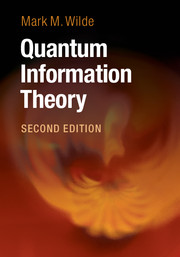Book contents
- Frontmatter
- Contents
- Preface to the Second Edition
- Preface to the First Edition
- How To Use This Book
- Part I Introduction
- Part II The Quantum Theory
- Part III Unit Quantum Protocols
- Part IV Tools of Quantum Shannon Theory
- Part V Noiseless Quantum Shannon Theory
- Part VI Noisy Quantum Shannon Theory
- Introduction
- 20 Classical Communication
- 21 Entanglement-Assisted Classical Communication
- 22 Coherent Communication with Noisy Resources
- 23 Private Classical Communication
- 24 Quantum Communication
- 25 Trading Resources for Communication
- 26 Summary and Outlook
- Appendix A Supplementary Results
- Appendix B Unique Linear Extension of a Quantum Physical Evolution
- References
- Index
24 - Quantum Communication
from Part VI - Noisy Quantum Shannon Theory
Published online by Cambridge University Press: 16 February 2017
- Frontmatter
- Contents
- Preface to the Second Edition
- Preface to the First Edition
- How To Use This Book
- Part I Introduction
- Part II The Quantum Theory
- Part III Unit Quantum Protocols
- Part IV Tools of Quantum Shannon Theory
- Part V Noiseless Quantum Shannon Theory
- Part VI Noisy Quantum Shannon Theory
- Introduction
- 20 Classical Communication
- 21 Entanglement-Assisted Classical Communication
- 22 Coherent Communication with Noisy Resources
- 23 Private Classical Communication
- 24 Quantum Communication
- 25 Trading Resources for Communication
- 26 Summary and Outlook
- Appendix A Supplementary Results
- Appendix B Unique Linear Extension of a Quantum Physical Evolution
- References
- Index
Summary
The quantum capacity theorem is one of the most important theorems in quantum Shannon theory. It is a fundamentally “quantum” theorem in that it demonstrates that a fundamentally quantum information quantity, the coherent information, is an achievable rate for quantum communication over a quantum channel. The fact that the coherent information does not have a strong analog in classical Shannon theory truly separates the quantum and classical theories of information.
The no-cloning theorem (Section 3.5.4) provides the intuition behind the quantum capacity theorem. The goal of any quantum communication protocol is for Alice to establish quantum correlations with the receiver Bob. We know well now that every quantum channel has an isometric extension, so that we can think of another receiver, the environment Eve, who is at a second output port of a larger unitary evolution. Were Eve able to learn anything about the quantum information that Alice is attempting to transmit to Bob, then Bob could not be retrieving this information—otherwise, they would violate the no-cloning theorem. Thus, Alice should figure out some subspace of the channel input where she can place her quantum information such that only Bob has access to it, while Eve does not. That the dimensionality of this subspace is exponential in the coherent information is perhaps then unsurprising in light of the above no-cloning reasoning. The coherent information is an entropy difference H(B)-H(E)—a measure of the amount of quantum correlations that Alice can establish with Bob less the amount that Eve can gain.
We proved achievability of the coherent information for quantum data transmission in Corollary 22.2.1, but the roundabout path that we followed to prove achievability there perhaps does not give much insight into the structure of a quantum code that achieves the coherent information. Our approach in this chapter is different and should shed more light on this structure. Specifically, we show how to make coherent versions of the private classical codes from the previous chapter.
- Type
- Chapter
- Information
- Quantum Information Theory , pp. 642 - 678Publisher: Cambridge University PressPrint publication year: 2017



